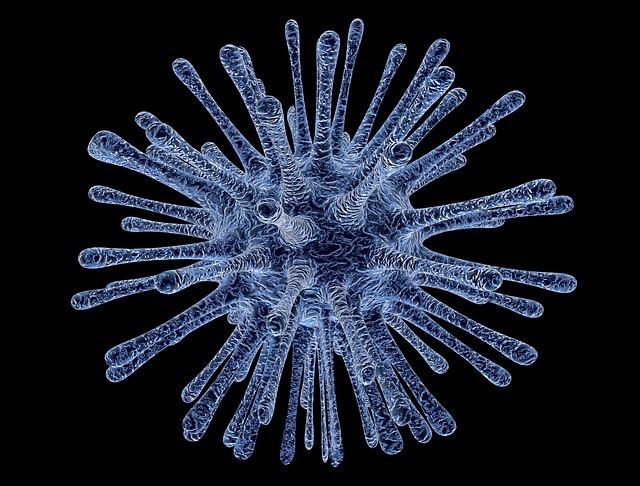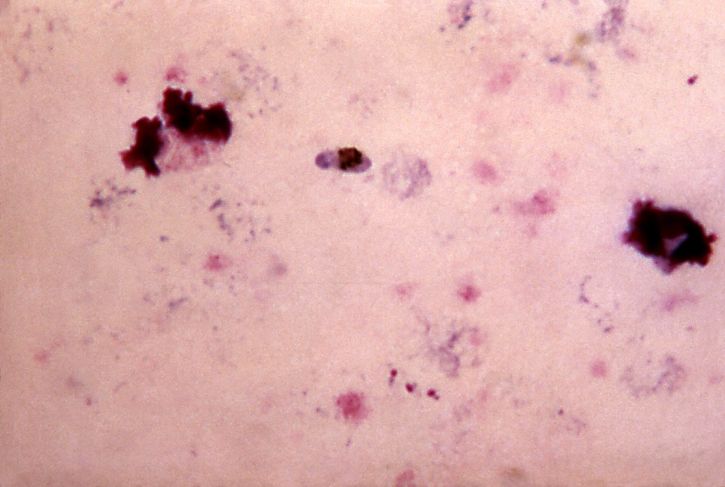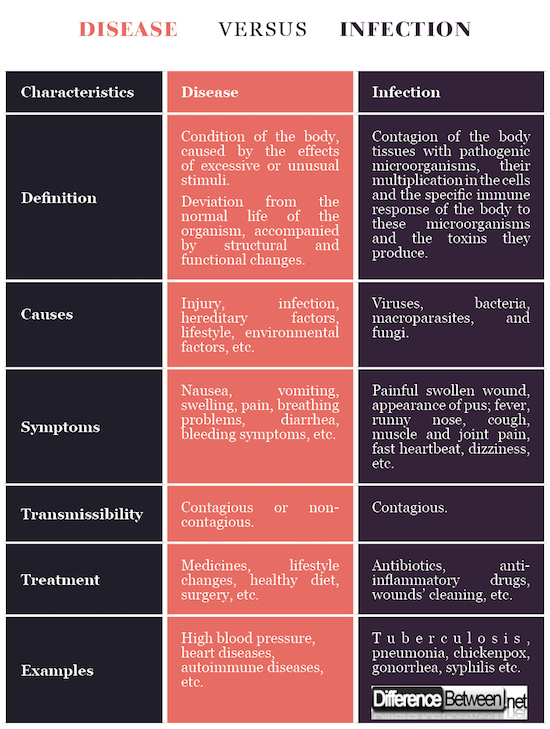Difference Between Disease and Infection
What is Disease?
Disease is a condition of the body, caused by the effects of excessive or unusual stimuli. It occurs with impaired homeostasis and reduced quality and efficiency of the life processes. It is a deviation from the normal life of the organism, accompanied by structural and functional changes.
The diseases can be contagious or non- contagious. They can be caused by:
- Injury;
- Infection;
- Hereditary factors;
- Environmental factors;
- Lifestyle – e.g. sedentary lifestyle, unhealthy diet, etc.
The disease passes through the following stages:
-
Latent (hidden) stage
The latent stage covers the period from the onset of the pathogenic factor to the first clinical sign. In infectious diseases, the latent stage is called incubation period. During this period the organisms are clinically healthy and show no visible signs of disease. At molecular, cellular and organ level, pathogenic changes induced by the action of the pathogenic factor develop. Protective-adaptive reactions also develop. In some cases, these may result in the destruction of the pathogenic agent. The latency period has a different duration and is determined by the strength and specific features of the pathogenic factor, and by the state of reactivity of the organism.
-
Prodromal stage
The prodromal stage covers the period from the appearance of the first clinical sign to the formation of the complete complex of symptoms of the disease. Through it, the defensive mechanisms of the organism are weakened. Metabolic, structural and functional disorders are exacerbated and manifest through external symptoms.
-
Stage of full clinical expression
During this stage, the pathological processes completely dominate over the protective-adaptive ones. Symptoms specific to the disease occur.
-
Ending stage
The last stage of the disease can continue to healing or pass into pathological condition and death.
The symptoms of the disease can be:
- Subjective – show how the body feels;
- Objective – observable symptoms;
- Conditionally-subjective – common symptoms occurring in a wide range of diseases.
Depending on the dynamics of the processes the diseases are:
- Peracute – last 1 to 3 days, sometimes for hours or even minutes; such are the most of the poisons, some allergic conditions, some infectious diseases;
- Acute – last 2 to 7 days; such are the most of the inflammatory processes and infectious diseases;
- Subacute – last 7 to 20 days; such are some bacterial and fungal infections;
- Chronic – last more than 20 days; such are the most of the autoimmune diseases, fungal infections.
What is Infection?
Infection is a contagion of the body tissues with pathogenic microorganisms, their multiplication in cells and the specific immune response of the body to these microorganisms and the toxins they produce. Infections are caused by viruses and bacteria. Larger organisms such as macroparasites (worms, ticks) and fungi (causing various mycoses) can also be a source of infection.
The ability of the microorganisms to cause an infection, whether it is clinically expressed or lacking symptoms, is called infectiousness.
The different species of macroorganisms in which a certain microorganism can cause infection is referred to as its infectious spectrum. The infectious spectrum of some microorganisms is very broad. For example, rabies virus causes infections in all mammal species. Other microbes have a narrow infectious spectrum. For example, in natural conditions the causes of gonorrhea and syphilis cause infections and diseases only in humans.
The symptoms of the infection depend on the type of the disease, and often on the type of the microorganism that causes them. Some of them affect the whole body:
- fatigue;
- loss of appetite;
- weight loss;
- temperature and chills;
- night sweats;
- pain.
There are also symptoms affecting individual parts of the body:
- skin – rashes;
- respiratory organs – cough, stuffy nose, runny nose;
- digestive tract – vomiting, abdominal pain.
For the treatment and recovery, it is especially important to identify if the infection is caused by virus or bacteria because the viruses are not affected by antibiotics. This distinction is not always easy because many of the symptoms of viral and bacterial infections overlap.
Viral infections are generally “systemic” – the symptoms affect different parts of the body at the same time: a runny nose, cough, muscle and joint pain. There are also ”local” viral infections which affect for example the eyes (conjunctivitis), the lips (herpes), etc.
The classic symptoms of bacterial infection are redness of the infected site, warming up, swelling and pain. The appearance of pus at the affected site is also a sign of bacterial infection.
Difference Between Disease and Infection
Definition
Disease: Disease is a condition of the body, caused by the effects of excessive or unusual stimuli. It is a deviation from the normal life of the organism, accompanied by structural and functional changes.
Infection: Infection is a contagion of the body tissues with pathogenic microorganisms, their multiplication in the cells and the specific immune response of the body to these microorganisms and the toxins they produce.
Causes
Disease: Diseases can be caused by injury, infection, hereditary factors, lifestyle, environmental factors, etc.
Infection: Infections are caused by viruses, bacteria, macroparasites, and fungi.
Symptoms
Disease: Nausea, vomiting, swelling, pain, breathing problems, diarrhea, bleeding symptoms, etc.
Infection: Painful swollen wound, appearance of pus; fever, runny nose, cough, muscle and joint pain, fast heartbeat, dizziness, etc.
Transmissibility
Disease: The diseases can be contagious or non- contagious.
Infection: The infections are contagious. They can transfer from an infected person to a healthy one.
Treatment
Disease: The treatment of diseases can include medicines, lifestyle changes, healthy diet, surgery, etc.
Infection: The treatment of infections can include antibiotics, anti-inflammatory drugs, wounds’ cleaning, etc.
Examples
Disease: High blood pressure, heart diseases, autoimmune diseases, etc.
Infection: Tuberculosis, pneumonia, chickenpox, gonorrhea, syphilis etc.
Comparison table to show the difference between disease and infection
Summary of infection vs disease:
- Disease is a condition of the body, caused by the effects of excessive or unusual stimuli. It is a deviation from the normal life of the organism, accompanied by structural and functional changes.
- Infection is a contagion of the body tissues with pathogenic microorganisms, their multiplication in the cells and the specific immune response of the body to these microorganisms and the toxins they produce.
- Diseases can be caused by injury, infection, hereditary factors, lifestyle, environmental factors, etc. Infections are caused by viruses, bacteria, macroparasites, and fungi.
- The symptoms depend on the type of the disease and infection. Symptoms of disease are nausea, vomiting, swelling, pain, breathing problems, diarrhea, bleeding symptoms, etc. Symptoms of infection are painful swollen wound, appearance of pus; fever, runny nose, cough, muscle and joint pain, fast heartbeat, dizziness, etc.
- The diseases can be contagious or non- contagious, while the infections are contagious.
- The treatment of diseases can include medicines, lifestyle changes, healthy diet, surgery, etc. The treatment of infections can include antibiotics, anti-inflammatory drugs, wounds’ cleaning, etc.
- Difference Between Gallstones and Cholecystitis - September 5, 2021
- Difference Between Constipation and Cramping - August 4, 2021
- Difference Between Whole Genome Sequencing and Microarray - May 6, 2021
Search DifferenceBetween.net :
Leave a Response
References :
[0]Image credit: https://pixnio.com/free-images/science/microscopy-images/malaria-plasmodium/infection-with-one-type-of-malaria-plasmodium-falciparum-if-not-promptly-treated-may-cause-kidney-failure-725x487.jpg
[1]Image credit: https://pixabay.com/en/virus-infected-cells-dna-disease-213708/
[2]Brooks, G., K. Carroll, J. Butel, S. Morse, T. Mietzner. Melnick&Adelbergs Medical Microbiology. 26th Edition. New York: McGraw-Hill Companies, Inc. 2013. Print.
[3]Humes, H., W. Kelley. Kelley's Textbook of Internal Medicine, Philadelphia: Lippincott Williams & Wilkins, 2000. Print.
[4]Sabatine, M. (Ed.). Pocket Medicine. 6th edition. Hong Kong: Wolters Kluwer. 2017. Print.



